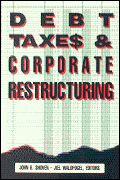Studies in this week’s Hutchins Roundup find student debt forgiveness benefits higher income individuals more than lower income individuals, large increases in corporate debt do not have lasting effects on the economy, and more.
Want to receive the Hutchins Roundup as an email? Sign up here to get it in your inbox every Thursday.
Universal student debt forgiveness disproportionately benefits high earners
Student debt tends to increase with income, since expensive graduate or professional degrees allow individuals to earn more after graduation. Because of programs like income-driven repayment (IDR) plans, which link repayments to income and forgive outstanding balances after a certain number of years, low-income families are also more likely to have their debt forgiven before they fully pay it off—making the relationship between debt and income even stronger. By comparing the effects of student loan forgiveness policies on expected total payments rather than current balances, Sylvain Catherine of UPenn’s Wharton and Constantine Yannelis of UChicago’s Booth School show that the benefits of universal loan forgiveness disproportionately accrue to high income earners; in fact, universal forgiveness would benefit the top 10% of earners “as much as the bottom three deciles combined,” and those in the bottom 50% would receive only a quarter of the total dollars forgiven by the policy. This pattern is similar for policies that universally forgive debt up to $10,000 or $50,000. A more progressive (and cheaper) option, the authors say, would be to expand the enrollment and generosity of IDR programs. Their analysis suggests that enrolling all borrowers who would benefit from IDR in the program would result in the bottom 50% of households receiving three fifths of the dollars forgiven, and that raising the income threshold for repayments would substantially increase benefits for households in the middle of the income distribution.
Business credit booms typically don’t leave lasting imprint on economy
Rising corporate debt in recent years has led to concerns that debt overhang could lead to deeper and more protracted recessions and stunt growth and investment. Using long-run historical data on corporate credit booms, Òscar Jordà of the Federal Reserve Bank of San Francisco and co-authors find no evidence that large increases in corporate debt affect either the growth and recovery of the economy after a downturn or the risk of larger crashes. For the most part, incentives for firms and corporate debtholders to effectively restructure debt prevent a lingering drag on the economy. In the presence of bankruptcy regimes that make it difficult for firms to restructure or liquidate, however, the authors find significant effects of debt overhang on recovery. Not only do these disincentives dampen investment, the authors argue, they also allow insolvent firms to be kept afloat, slowing long-run aggregate productivity growth.
Remote work is likely to increase after the pandemic relative to pre-pandemic levels
COVID-19 has proved to employers and employees that sustained remote work presents a viable business model for many – but will it change the way we do business in the future? Surveying 15,000 working-age Americans between May and October 2020, Jose Maria Barrero of the Instituto Tecnológico Autónomo de México, Nicholas Bloom of Stanford, and Steven J. Davis of UChicago argue that it will. According to the survey, workers who are currently teleworking estimate that employers are planning to have employees telework about one day per week, four times more than in pre-pandemic times. The authors find that perceptions of working from home have improved and that the majority of workers and firms have had a more positive experience than expected. In addition, workers and firms have already invested substantially in remote work infrastructure—about $660 in equipment and 13 hours in time on average from workers, for example—which will reduce the cost of remote work after the pandemic. The authors estimate that continuing to telework at higher rates after the pandemic will increase worker productivity by 2.4% and could lower post-COVID worker expenditures in central business districts by 5-10% of taxable sales.
Chart of the week: The K-Shaped Economy
Quote of the week:
“President-elect Biden has made very clear over the course of these past two years that he feels very passionately we need to be on a path of fiscal sustainability and that he wants to show how he’s going to pay for all of the long-term permanent programs that he is proposing and hopes to pass after January 20th,” says Jake Sullivan, National Security Adviser-designate.
“But he has also made clear that we need to make some investments up front, right now, to get this economy going that aren’t going to be paid for – and that actually if we don’t make those investments our long-term debt burden is going to be greater, our economy is going to be weaker, our fiscal picture is going to be less sound. So his vision is a combination of up-front, one time significant investment to jump start a serious, speedy economic recovery, and then to show how he will pay for the long-term ongoing costs.”












Commentary
Hutchins Roundup: Student debt forgiveness, credit booms, and more
December 10, 2020